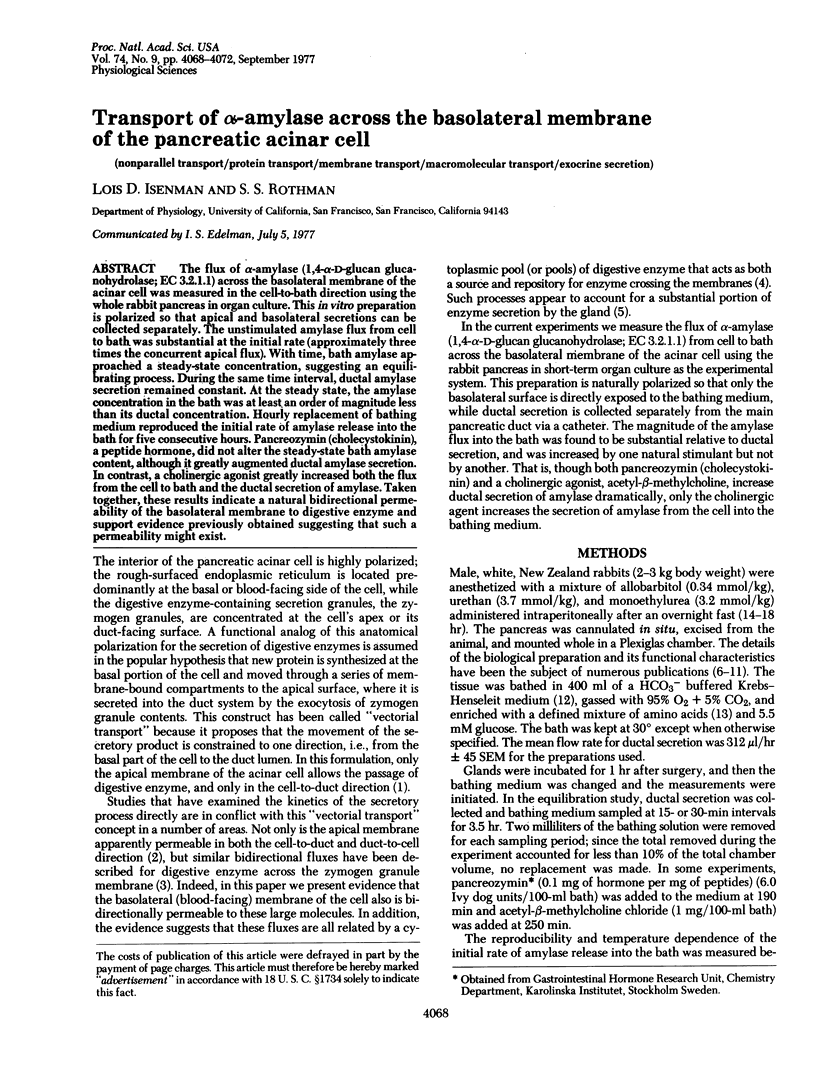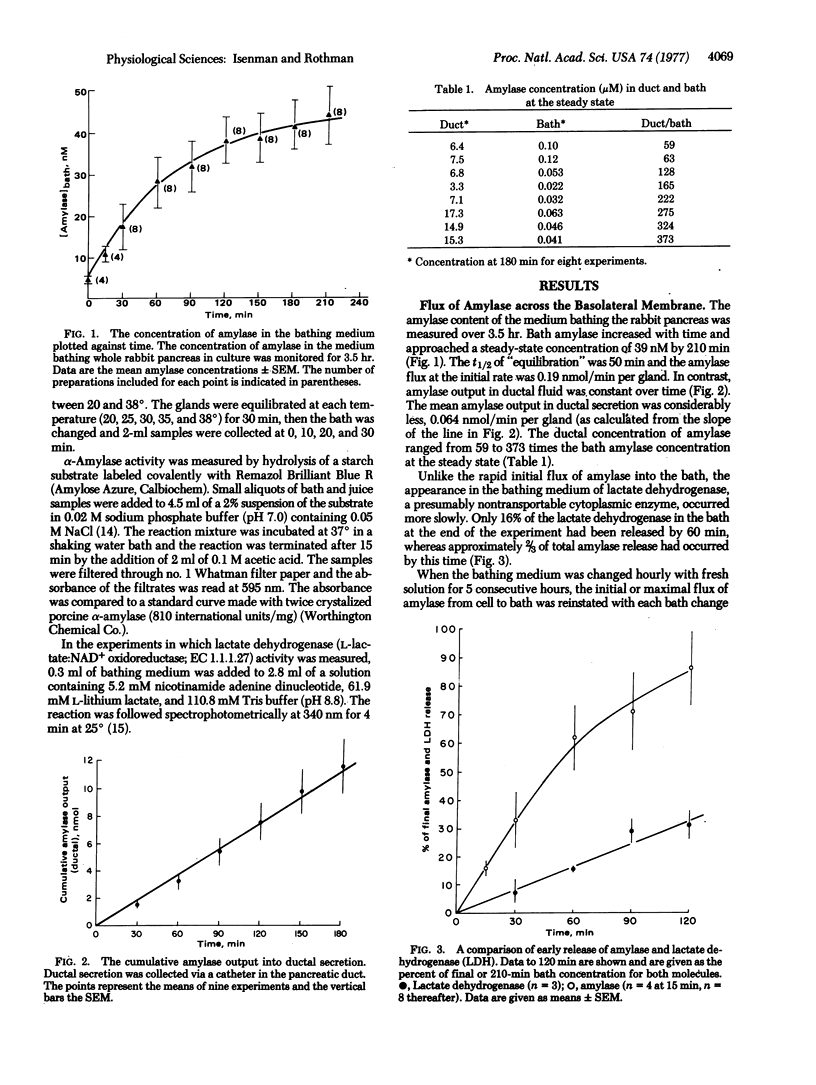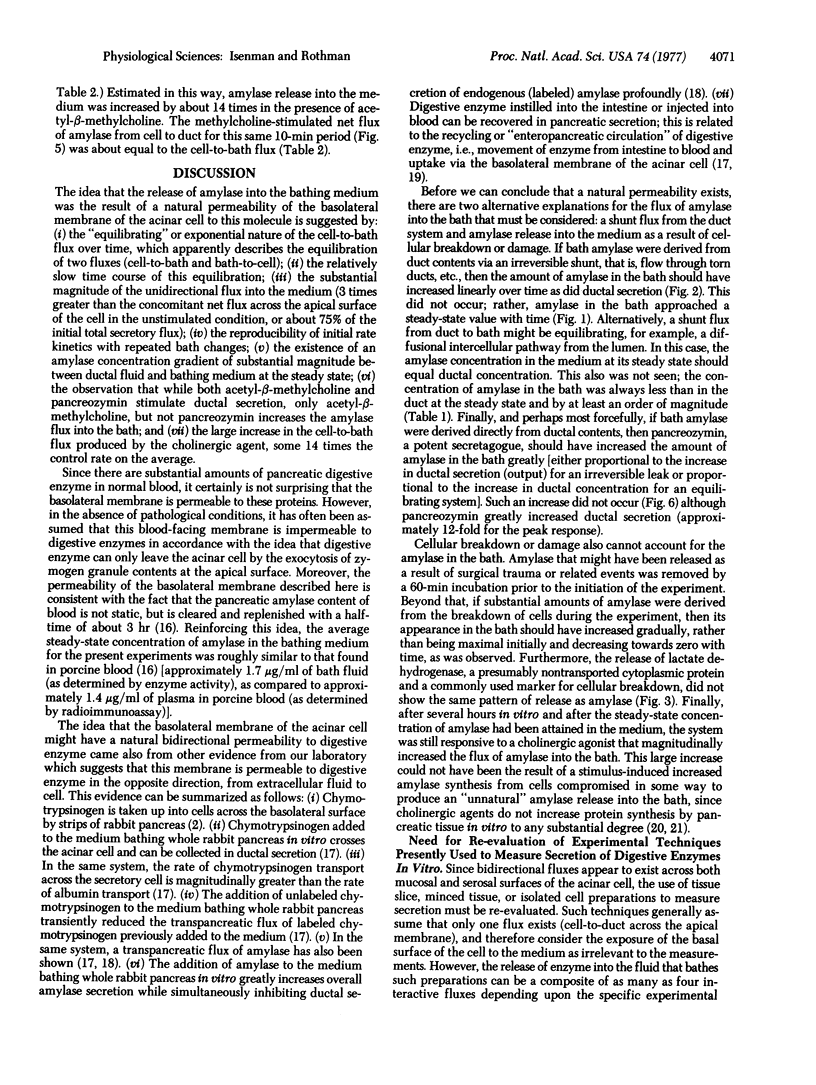Abstract
The flux of alpha-amylase (1,4-alpha-D-glucan glucanohydrolase; EC 3.2.1.1) across the basolateral membrane of the acinar cell was measured in the cell-to-bath direction using the whole rabbit pancreas in organ culture. This in vitro preparation is polarized so that apical and basolateral secretions can be collected separately. The unstimulated amylase flux from cell to bath was substantial at the initial rate (approximately three times the concurrent apical flux). With time, bath amylase approached a steady-state concentration, suggesting an equilbrating process. During the same time interval, ductal amylase secretion remained constant. At the steady state, the amylase concentration in the bath was at least an order of magnitude less than its ductal concentration. Hourly replacement of bathing medium reproduced the initial rate of amylase release into the bath for five consecutive hours. Pancreozymin (cholecystokinin), a peptide hormone, did not alter the steady-state bath amylase content, although it greatly augmented ductal amylase secretion. In contrast, a cholinergic agonist greatly increased both the flux from the cell to bath and the ductal secretion of amylase. Taken together, these results indicate a natural bidirectional permeability of the basolateral membrane to digestive enzyme and support evidence previously obtained suggesting that such a permeability might exist.
Full text
PDF




Selected References
These references are in PubMed. This may not be the complete list of references from this article.
- AMADOR E., DORFMAN L. E., WACKER W. E. SERUM LACTIC DEHYDROGENASE ACTIVITY: AN ANALYTICAL ASSESSMENT OF CURRENT ASSAYS. Clin Chem. 1963 Aug;12:391–399. [PubMed] [Google Scholar]
- EAGLE H. Amino acid metabolism in mammalian cell cultures. Science. 1959 Aug 21;130(3373):432–437. doi: 10.1126/science.130.3373.432. [DOI] [PubMed] [Google Scholar]
- Götze H., Rothman S. S. Enteropancreatic circulation of digestive enzyme as a conservation mechanism. Nature. 1975 Oct 16;257(5527):607–609. doi: 10.1038/257607a0. [DOI] [PubMed] [Google Scholar]
- Heisler S., Fast D., Tenenhouse A. Role of Ca 2+ and cyclic AMP in protein secretion from rat exocrine pancreas. Biochim Biophys Acta. 1972 Oct 25;279(3):561–572. doi: 10.1016/0304-4165(72)90178-x. [DOI] [PubMed] [Google Scholar]
- Jamieson J. D., Palade G. E. Synthesis, intracellular transport, and discharge of secretory proteins in stimulated pancreatic exocrine cells. J Cell Biol. 1971 Jul;50(1):135–158. doi: 10.1083/jcb.50.1.135. [DOI] [PMC free article] [PubMed] [Google Scholar]
- Leibow C., Rothman S. S. Enteropancreatic circulation of digestive enzymes. Science. 1975 Aug 8;189(4201):472–474. doi: 10.1126/science.1154022. [DOI] [PubMed] [Google Scholar]
- Liebow C., Rothman S. S. Membrane transport of proteins. Nat New Biol. 1972 Dec 6;240(101):176–178. doi: 10.1038/newbio240176a0. [DOI] [PubMed] [Google Scholar]
- Liebow C., Rothman S. S. Transport of bovine chymotrypsinogen into rabbit pancreatic cells. Am J Physiol. 1974 May;226(5):1077–1081. doi: 10.1152/ajplegacy.1974.226.5.1077. [DOI] [PubMed] [Google Scholar]
- Morisset J. A., Webster P. D. In vitro and in vivo effects of pancreozymin, urecholine, and cyclic AMP on rat pancreas. Am J Physiol. 1971 Jan;220(1):202–208. doi: 10.1152/ajplegacy.1971.220.1.202. [DOI] [PubMed] [Google Scholar]
- Palade G. Intracellular aspects of the process of protein synthesis. Science. 1975 Aug 1;189(4200):347–358. doi: 10.1126/science.1096303. [DOI] [PubMed] [Google Scholar]
- ROTHMAN S. S., BROOKS F. P. ELECTROLYTE SECRETION FROM RABBIT PANCREAS IN VITRO. Am J Physiol. 1965 Jun;208:1171–1176. doi: 10.1152/ajplegacy.1965.208.6.1171. [DOI] [PubMed] [Google Scholar]
- ROTHMAN S. S. EXOCRINE SECRETION FROM THE ISOLATED RABBIT PANCREAS. Nature. 1964 Oct 3;204:84–85. doi: 10.1038/204084a0. [DOI] [PubMed] [Google Scholar]
- Reber H. A., Wolf C. J. Micropuncture study of pancreatic electrolyte secretion. Am J Physiol. 1968 Jul;215(1):34–40. doi: 10.1152/ajplegacy.1968.215.1.34. [DOI] [PubMed] [Google Scholar]
- Ridderstap A. S., Bonting S. L. Na+- K+-activated ATPase anc exocrine pancreatic secretion in vitro. Am J Physiol. 1969 Dec;217(6):1721–1727. doi: 10.1152/ajplegacy.1969.217.6.1721. [DOI] [PubMed] [Google Scholar]
- Rinderknecht H., Wilding P., Haverback B. J. A new method for the determination of alpha-amylase. Experientia. 1967 Oct 15;23(10):805–805. doi: 10.1007/BF02146851. [DOI] [PubMed] [Google Scholar]
- Rothman S. S. Enzyme secretion in the absense of zymogen granules. Am J Physiol. 1975 Jun;228(6):1828–1834. doi: 10.1152/ajplegacy.1975.228.6.1828. [DOI] [PubMed] [Google Scholar]
- Rothman S. S. Protein transport by the pancreas. Science. 1975 Nov 21;190(4216):747–753. doi: 10.1126/science.1105785. [DOI] [PubMed] [Google Scholar]
- Ryan J., Appert H. Circulatory turnover of pancreatic amylase. Proc Soc Exp Biol Med. 1975 Sep;149(4):921–925. doi: 10.3181/00379727-149-38927. [DOI] [PubMed] [Google Scholar]
- Swanson C. H., Solomon A. K. A micropuncture investigation of the whole tissue mechanism of electrolyte secretion by the in vitro rabbit pancreas. J Gen Physiol. 1973 Oct;62(4):407–429. doi: 10.1085/jgp.62.4.407. [DOI] [PMC free article] [PubMed] [Google Scholar]
- Welch R. W., Littman A. Protein output by the in vitro rabbit pancreas. J Appl Physiol. 1974 Aug;37(2):235–238. doi: 10.1152/jappl.1974.37.2.235. [DOI] [PubMed] [Google Scholar]


